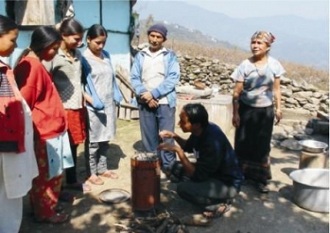WHO – Pneumonia Fact Sheet, August 2012
Key facts
- Pneumonia is the leading cause of death in children worldwide.
- Pneumonia kills an estimated 1.4 million children under the age of five years every year – more than AIDS, malaria and tuberculosis combined.
- Pneumonia can be caused by viruses, bacteria or fungi.
- Pneumonia can be prevented by immunization, adequate nutrition and by addressing environmental factors.
- Pneumonia can be treated with antibiotics, but around 30% of children with pneumonia receive the antibiotics they need.
Pneumonia is a form of acute respiratory infection that affects the lungs. The lungs are made up of small sacs called alveoli, which fill with air when a healthy person breathes. When an individual has pneumonia, the alveoli are filled with pus and fluid, which makes breathing painful and limits oxygen intake.
Pneumonia is the single largest cause of death in children worldwide. Every year, it kills an estimated 1.4 million children under the age of five years, accounting for 18% of all deaths of children under five years old worldwide. Pneumonia affects children and families everywhere, but is most prevalent in South Asia and sub-Saharan Africa. Children can be protected from pneumonia, it can be prevented with simple interventions, and treated with low-cost, low-tech medication and care.
Causes
Pneumonia is caused by a number of infectious agents, including viruses, bacteria and fungi. The most common are:
- Streptococcus pneumoniae – the most common cause of bacterial pneumonia in children;
- Haemophilus influenzae type b (Hib) – the second most common cause of bacterial pneumonia; respiratory syncytial virus is the most common viral cause of pneumonia; in infants infected with HIV, Pneumocystis jiroveci is one of the commonest causes of pneumonia, responsible for at least one quarter of all pneumonia deaths in HIV-infected infants.
Transmission
Pneumonia can be spread in a number of ways. The viruses and bacteria that are commonly found in a child’s nose or throat, can infect the lungs if they are inhaled. They may also spread via air-borne droplets from a cough or sneeze. In addition, pneumonia may spread through blood, especially during and shortly after birth. More research needs to be done on the different pathogens causing pneumonia and the ways they are transmitted, as this has critical importance for treatment and prevention.
Symptoms
The symptoms of viral and bacterial pneumonia are similar. However, the symptoms of viral pneumonia may be more numerous than the symptoms of bacterial pneumonia.
The symptoms of pneumonia include:
- rapid or difficult breathing
- cough
- fever
- chills
- loss of appetite
- wheezing (more common in viral infections).
When pneumonia becomes severe, children may experience lower chest wall indrawing, where their chests move in or retract during inhalation (in a healthy person, the chest expands during inhalation). Very severely ill infants may be unable to feed or drink and may also experience unconsciousness, hypothermia and convulsions.
Risk factors
While most healthy children can fight the infection with their natural defences, children whose immune systems are compromised are at higher risk of developing pneumonia. A child’s immune system may be weakened by malnutrition or undernourishment, especially in infants who are not exclusively breastfed.
Pre-existing illnesses, such as symptomatic HIV infections and measles, also increase a child’s risk of contracting pneumonia.
The following environmental factors also increase a child’s susceptibility to pneumonia:
- indoor air pollution caused by cooking and heating with biomass fuels (such as wood or dung)
- living in crowded homes
- parental smoking.
Treatment
Pneumonia can be treated with antibiotics. These are usually prescribed at a health centre or hospital, but the vast majority of cases of childhood pneumonia can be administered managed effectively within the home. Hospitalization is recommended in infants aged two months and younger, and also in very severe cases.
Prevention
Preventing pneumonia in children is an essential component of a strategy to reduce child mortality. Immunization against Hib, pneumococcus, measles and whooping cough (pertussis) is the most effective way to prevent pneumonia.
Adequate nutrition is key to improving children’s natural defences, starting with exclusive breastfeeding for the first six months of life. In addition to being effective in preventing pneumonia, it also helps to reduce the length of the illness if a child does become ill.
Addressing environmental factors such as indoor air pollution (by providing affordable clean indoor stoves, for example) and encouraging good hygiene in crowded homes also reduces the number of children who fall ill with pneumonia.
In children infected with HIV, the antibiotic cotrimoxazole is given daily to decrease the risk of contracting pneumonia.
Economic costs
Research has shown that prevention and proper treatment of pneumonia could avert one million deaths in children every year. With proper treatment alone, 600 000 deaths could be avoided.
The cost of antibiotic treatment for all children with pneumonia in 42 of the world’s poorest countries is estimated at around US$ 600 million per year. Treating pneumonia in South Asia and sub-Saharan Africa – which account for 85% of deaths – would cost a third of this total, at around US$ 200 million. The price includes the antibiotics themselves, as well as the cost of training health workers, which strengthens the health systems as a whole.
WHO response
In 2009, WHO and UNICEF launched the Global action plan for the prevention and control of pneumonia (GAPP). The aim is to accelerate pneumonia control with a combination of interventions to protect, prevent, and treat pneumonia in children with actions to:
- protect children from pneumonia include promoting exclusive breastfeeding and hand washing, and reducing indoor air pollution;
- prevent pneumonia with vaccinations;
- treat pneumonia are focused on making sure that every sick child has access to the right kind of care — either from a community-based health worker, or in a health facility if the disease is severe — and can get the antibiotics and oxygen they need to get well.




